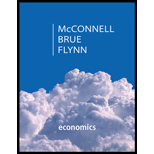
EBK ECONOMICS
20th Edition
ISBN: 9780077660710
Author: McConnell
Publisher: MCGRAW-HILL HIGHER EDUCATION
expand_more
expand_more
format_list_bulleted
Question
Chapter 38, Problem 3DQ
To determine
The productive efficiency.
Expert Solution & Answer
Trending nowThis is a popular solution!

Students have asked these similar questions
(d) Calculate the total change in qı.
Total change:
007
(sp) S
to vlijnsi
(e) B₁ is our original budget constraint and B2 is our new budget constraint after the price of good 1 (p1) increased.
Decompose the change in qı (that occurred from the increase in p₁) into the income and substitution effects. It
is okay to estimate as needed via visual inspection. Add any necessary information to the graph to support your
03
answer.
Substitution Effect:
Income Effect:
everything is in image (8 and 10) there are two images each separate questions
everything is in the picture (13)
the first blank has the options (an equilibrium or a surplus)
the second blank has the options (a surplus or a shortage)
Chapter 38 Solutions
EBK ECONOMICS
Ch. 38.2 - Prob. 1QQCh. 38.2 - Prob. 2QQCh. 38.2 - Prob. 3QQCh. 38.2 - Prob. 4QQCh. 38 - Prob. 1DQCh. 38 - Prob. 2DQCh. 38 - Prob. 3DQCh. 38 - Prob. 4DQCh. 38 - Prob. 5DQCh. 38 - Prob. 6DQ
Ch. 38 - Prob. 7DQCh. 38 - Prob. 8DQCh. 38 - Prob. 9DQCh. 38 - Prob. 10DQCh. 38 - Prob. 11DQCh. 38 - Prob. 12DQCh. 38 - Prob. 13DQCh. 38 - Prob. 14DQCh. 38 - Prob. 1RQCh. 38 - Prob. 2RQCh. 38 - Prob. 3RQCh. 38 - Prob. 4RQCh. 38 - Prob. 5RQCh. 38 - Prob. 6RQCh. 38 - Prob. 7RQCh. 38 - Prob. 8RQCh. 38 - Prob. 9RQCh. 38 - Prob. 10RQCh. 38 - Prob. 11RQCh. 38 - Prob. 12RQCh. 38 - Prob. 13RQCh. 38 - Prob. 1PCh. 38 - Prob. 2PCh. 38 - Prob. 3PCh. 38 - Prob. 4P
Knowledge Booster
Similar questions
- everything is in photo (19)arrow_forwardIn announcing tariffs on imported steel and aluminum last week, the President said he was imposing a tax on foreign manufacturers who seek to export to the U.S. Is that a fair description of what he did and who will pay? Explain your answer.arrow_forwardAnticipating a severe winter storm, stores stock up on snow shovels and consumers buy snow shovels to be able to clear access to their property. What happens to the price and quantity of snow shovels in the days leading up to the stormarrow_forward
- In the context of supply and demand, describe what equilibrium means? Can a shortage or surplus exist in a market that is left to its own devices? Explain.arrow_forwardTypically, spending in an economy is divided into four components. What are they? Which is the largest component? Which is the most steady from one period to another? Which is most volatile from one period to another? Explain why for your two previous answers.arrow_forwardMichelle Wie, a teenage golf prodigy, earned $16 million from endorsements and $4 million in prize money in 2006. In 2007, she announced that she would enroll in Stanford University for the Fall term. What was her opportunity cost for the 2007-2008 academic year? How does it compare to your opportunity cost of a year at University?arrow_forward
arrow_back_ios
SEE MORE QUESTIONS
arrow_forward_ios
Recommended textbooks for you
 Essentials of Economics (MindTap Course List)EconomicsISBN:9781337091992Author:N. Gregory MankiwPublisher:Cengage Learning
Essentials of Economics (MindTap Course List)EconomicsISBN:9781337091992Author:N. Gregory MankiwPublisher:Cengage Learning Brief Principles of Macroeconomics (MindTap Cours...EconomicsISBN:9781337091985Author:N. Gregory MankiwPublisher:Cengage Learning
Brief Principles of Macroeconomics (MindTap Cours...EconomicsISBN:9781337091985Author:N. Gregory MankiwPublisher:Cengage Learning Principles of Economics, 7th Edition (MindTap Cou...EconomicsISBN:9781285165875Author:N. Gregory MankiwPublisher:Cengage Learning
Principles of Economics, 7th Edition (MindTap Cou...EconomicsISBN:9781285165875Author:N. Gregory MankiwPublisher:Cengage Learning Principles of Economics (MindTap Course List)EconomicsISBN:9781305585126Author:N. Gregory MankiwPublisher:Cengage Learning
Principles of Economics (MindTap Course List)EconomicsISBN:9781305585126Author:N. Gregory MankiwPublisher:Cengage Learning Principles of Macroeconomics (MindTap Course List)EconomicsISBN:9781285165912Author:N. Gregory MankiwPublisher:Cengage Learning
Principles of Macroeconomics (MindTap Course List)EconomicsISBN:9781285165912Author:N. Gregory MankiwPublisher:Cengage Learning Principles of Macroeconomics (MindTap Course List)EconomicsISBN:9781305971509Author:N. Gregory MankiwPublisher:Cengage Learning
Principles of Macroeconomics (MindTap Course List)EconomicsISBN:9781305971509Author:N. Gregory MankiwPublisher:Cengage Learning

Essentials of Economics (MindTap Course List)
Economics
ISBN:9781337091992
Author:N. Gregory Mankiw
Publisher:Cengage Learning

Brief Principles of Macroeconomics (MindTap Cours...
Economics
ISBN:9781337091985
Author:N. Gregory Mankiw
Publisher:Cengage Learning

Principles of Economics, 7th Edition (MindTap Cou...
Economics
ISBN:9781285165875
Author:N. Gregory Mankiw
Publisher:Cengage Learning

Principles of Economics (MindTap Course List)
Economics
ISBN:9781305585126
Author:N. Gregory Mankiw
Publisher:Cengage Learning

Principles of Macroeconomics (MindTap Course List)
Economics
ISBN:9781285165912
Author:N. Gregory Mankiw
Publisher:Cengage Learning

Principles of Macroeconomics (MindTap Course List)
Economics
ISBN:9781305971509
Author:N. Gregory Mankiw
Publisher:Cengage Learning